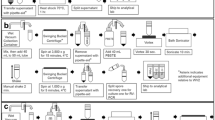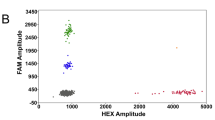Abstract
Analytical methods exist to detect biothreat agents in environmental samples during a response to biological contamination incidents. However, the coastal zone facilities and assets of the US Coast Guard (USCG), including response boats in diverse geographical areas and maritime environmental conditions, can pose complex and unique challenges for adapting existing analytical detection methods. The traditional culture (TC) and the rapid viability polymerase chain reaction (RV-PCR) methods were evaluated for their compatibility for maritime environmental surface and grab sample analysis to detect spores of Bacillus thuringiensis subspecies kurstaki (Btk), a surrogate for Bacillus anthracis. The representative samples collected from a USCG installation included surfaces, such as aluminum on boats, nonskid tread on decks of watercraft, computer touchscreens, and concrete piers, and grab samples of boat washdown water, soil, vegetation, and gravel from surrounding areas. Replicate samples were spiked with Btk spores at two to three tenfold increasing levels and analyzed. Out of a total of 150 samples collected and analyzed, the TC method gave 10 false-positive and 19 false-negative results, while the RV-PCR method-based analysis resulted in 0 false-positive and 26 false-negative results. An abundance of microbial background and particulates in some samples interfered with true results, while both methods gave similar results for samples with low microbial background and particulates. Improved and high-throughput sample processing methods are needed for analysis of complex environmental samples.




Similar content being viewed by others
Data availability
All data will be publicly available at data.gov.
References
Boehm, A. B., Griffith, J., McGee, C., Edge, T. A., Solo-Gabriele, H. M., Whitman, R., Cao, Y., Getrich, M., Jay, J. A., Ferguson, D., Goodwin, K. D., Lee, C. M., Madison, M., & Weisberg, S. B. (2009). Faecal indicator bacteria enumeration in beach sand: A comparison study of extraction methods in medium to coarse sands. Journal of Applied Microbiology, 107(5), 1740–1750. https://doi.org/10.1111/j.1365-2672.2009.04440.x
Buckley, P., Rivers, B., Katoski, S., Kim, M. H., Kragl, F. J., Broomall, S., Krepps, M., Skowronski, E. W., Rosenzweig, C. W., Paikoff, S., Emanuel, P., & Gibbons, H. S. (2012). Genetic barcodes for improved environmental tracking of an anthrax simulant. Applied and Environment Microbiology, 78(23), 8272–8280.
Calfee, M. W., Rose, L. J., Morse, S., Mattorano, D., Clayton, M., Touati, A., Griffin-Gatchalian, N., Slone, C., & McSweeney, N. (2013). Comparative evaluation of vacuum-based surface sampling methods for collection of Bacillus spores. Journal of Microbiological Methods, 95(3), 389–396. https://doi.org/10.1016/j.mimet.2013.10.015
Kim, H., & Goepfert, J. (1974). A sporulation medium for Bacillus anthracis. Journal of Applied Bacteriology, 37(2), 265–267. https://doi.org/10.1111/j.1365-2672.1974.tb00438.x
Létant, S. E., Murphy, G. A., Alfaro, T. M., Avila, J. R., Kane, S. R., Raber, E., Bunt, T. M., & Shah, S. R. (2011). Rapid-viability PCR method for detection of live, virulent Bacillus anthracis in environmental samples. Applied and Environmental Microbiology, 77(18), 6570–6578. https://doi.org/10.1128/AEM.00623-11
Mikelonis, A. M., Abdel-Hady, A., Aslett, D., Ratliff, K., Touati, A., Archer, J., Serre, S., Mickelsen, L., Taft, S., & Calfee, M. W. (2020). Comparison of surface sampling methods for an extended duration outdoor biological contamination study. Environmental Monitoring and Assessment, 192(7), 455. https://doi.org/10.1007/s10661-020-08434-8
Rose, L. J., Hodges, L., O’Connell, H., & Noble-Wang, J. (2011). National validation study of a cellulose sponge wipe-processing method for use after sampling Bacillus anthracis spores from surfaces. Applied and Environmental Microbiology, 77(23), 8355–8359. https://doi.org/10.1128/AEM.05377-11
Serre, S., & Oudejans, L. (2017). Underground transport restoration (UTR) Operational technology demonstration (OTD). U.S. Environmental Protection Agency, Washington, DC, EPA/600/R-17/272.
Shah, S. (2017). Protocol for detection of Bacillus anthracis in environmental samples during the remediation phase of an anthrax incident, 2nd edition. U.S. Environmental Protection Agency, Washington, DC. Retrieved June 5, 2022, from https://cfpub.epa.gov/si/si_public_record_report.cfm?Lab=NHSRC&dirEntryId=338673
US Environmental Protection Agency. (2022). Environmental Sampling and Analytical Methods (ESAM) program. https://www.epa.gov/esam
Acknowledgements
We thank Hiba Shamma, Anthony Smith, Lindsay Catlin, Nate Poland, Ken Connelly, Dave Albertson, and Emily Breech at Battelle Memorial Institute for their execution of sample processing over the course of the study. We thank Patrick Keyes at Battelle Memorial Institute for environmental sample collection. We also thank Christine Tomlinson, EPA Office of Land and Emergency Management, and Kristen Willis, EPA Office of Chemical Safety and Pollution Prevention, for technical review of this manuscript.
Funding
This study was a part of the Analysis for Coastal Operational Resiliency (AnCOR) Project for which the funding was provided to the US Environmental Protection Agency (EPA) by the US Department of Homeland Security Science and Technology Directorate (DHS S&T) under the interagency agreement, 70RSAT-18-K-PM-000084. The US EPA through its Office of Research and Development (ORD) managed the research described here under a contract with the Battelle Memorial Institute under EPA Contract Number EP-C-16–014; Task Order 68HERC20F0237.
Author information
Authors and Affiliations
Contributions
S.S., W.C., S.N., K.H., and R.J. contributed to the design and implementation of the research. S.S., W.C., S.S., E.B., C.G., L.O., L.M., J.T., D.B., and S.T. supervised and helped shape the direction of the research. All authors provided critical feedback and helped shape the research, analysis, and manuscript.
Corresponding author
Ethics declarations
Conflict of interest
The authors declare no competing interests.
Disclaimer
This manuscript has been subject to an administrative review but does not necessarily reflect the views of the US Environmental Protection Agency (EPA). No official endorsement should be inferred. EPA does not endorse the purchase or sale of any commercial products or services.
Additional information
Publisher's Note
Springer Nature remains neutral with regard to jurisdictional claims in published maps and institutional affiliations.
Supplementary Information
Below is the link to the electronic supplementary material.
Rights and permissions
About this article
Cite this article
Nelson, S., Hofacre, K., Calfee, M.W. et al. Evaluation of two methods for detection of viable Bacillus anthracis simulant spores in maritime environmental samples. Environ Monit Assess 195, 257 (2023). https://doi.org/10.1007/s10661-022-10772-8
Received:
Accepted:
Published:
DOI: https://doi.org/10.1007/s10661-022-10772-8




